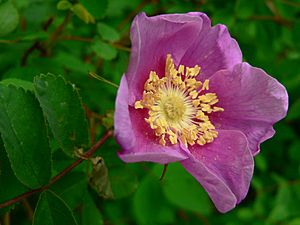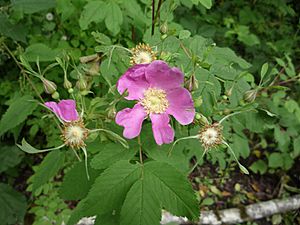Nootka rose facts for kids
Quick facts for kids Nootka rose |
|
|---|---|
 |
|
| Scientific classification | |
| Genus: |
Rosa
|
| Species: |
nutkana
|
| Varieties | |
|
|
The Rosa nutkana, also known as the Nootka rose or wild rose, is a type of plant called a shrub in the rose family (Rosaceae). It can grow from 2 to 10 feet (about 0.6 to 3 meters) tall.
The name nootka comes from the Nootka Sound on Vancouver Island. This is where the plant was first studied and described. This rose is native to Western North America. There are two main types, called varieties. One type, hispida, grows in the mountains and dry areas. The other, nutkana, grows closer to the coast, from Alaska down to California.
Contents
What the Nootka Rose Looks Like
The Nootka rose can grow up to 3 meters (about 10 feet) tall. It often forms dense groups of plants. It has light green leaves with jagged edges. The plant has sharp prickles (like thorns) at the base of its leaves. These prickles are usually straight and grow in pairs where the leaves join the stem.
Its flowers are about 5 to 8 centimeters (2 to 3 inches) wide. They are usually found alone, but sometimes you might see 2 or 3 together. These flowers bloom in early summer and smell really nice. The sepals (leaf-like parts under the petals) are very long. They are even longer than the petals themselves and are narrow in the middle.
The fruits of the Nootka rose are called rose hips. They are a bit bitter but you can eat them. If you let them get very ripe, they become less bitter and taste much better. Only eat the outer part (rind) of the hip, because the seeds inside can be irritating.
Where the Nootka Rose Grows and Lives
The Nootka rose can grow in many different places. It grows from close to the sea up to higher elevations in the mountains. It likes sunshine but can also grow in some shade. You often find it at the edge of forests. It can grow in wet soils near rivers or in dry, rocky soils. You might see it in fencerows, hedgerows, pastures, wetlands, woodlands, prairies, and meadows.
Thick groups of Nootka rose plants provide a home and food for birds and small animals. Deer eat the flowers, young stems, and rose hips. These plants are also used to help restore wetlands. People also plant them in gardens because they are native plants.
The Nootka rose is a host plant for certain gall wasps. These wasps lay their eggs on the plant, which causes the plant to grow strange bumps called galls. Two types of wasps that do this are D. polita and D. rosae. D. polita makes bristly, round galls on the leaves. D. rosae makes large, mossy, feathery growths on the stems.
How People Use the Nootka Rose
Many indigenous peoples have used the Nootka rose for different purposes. They used it as medicine, in ceremonies, for making crafts, and as a food source. For example, branches or leaves were used to make a tea or a poultice (a soft, moist mass applied to the body) to treat sores and eye problems.
Like all wild rose plants, the rose hips are edible. People sometimes use them to make jams and jellies.
The Nootka rose is also important for butterflies. It is a food source for the caterpillars of the mourning cloak and grey hairstreak butterflies.
You can grow Nootka rose from seeds, but it can be tricky. You can also grow new plants from cuttings of the stems or from root suckers (new shoots that grow from the roots).
There are also several types of Nootka rose grown in gardens. These are called cultivars. Some examples include 'Cantab', 'Mander's Nutkana #1', 'Moore's Nutkana', and 'Schoener's Nutkana'.
See also
 In Spanish: Rosa nutkana para niños
In Spanish: Rosa nutkana para niños



